Brand Management Report: M&S Branding, Equity, and Strategies
VerifiedAdded on 2020/06/06
|17
|4870
|480
Report
AI Summary
This report delves into the intricacies of brand management, focusing on Marks and Spencer (M&S) as a case study. It begins by highlighting the importance of branding in the market, discussing how brands differentiate products and services and build customer relationships. The report then analyzes the development and growth of brand equity, exploring the Keller brand equity model and its application. It also examines strategies to reinforce, extend, and revitalize the M&S brand. The report further explores different portfolio management strategies, including the house of brands, branded house, and hybrid models. Finally, it addresses brand leverage, M&S's strengths and weaknesses, potential collaboration and partnership options, and methods for measuring and managing brand value. The report offers a comprehensive overview of brand management principles and their practical application within the context of a major retail brand.
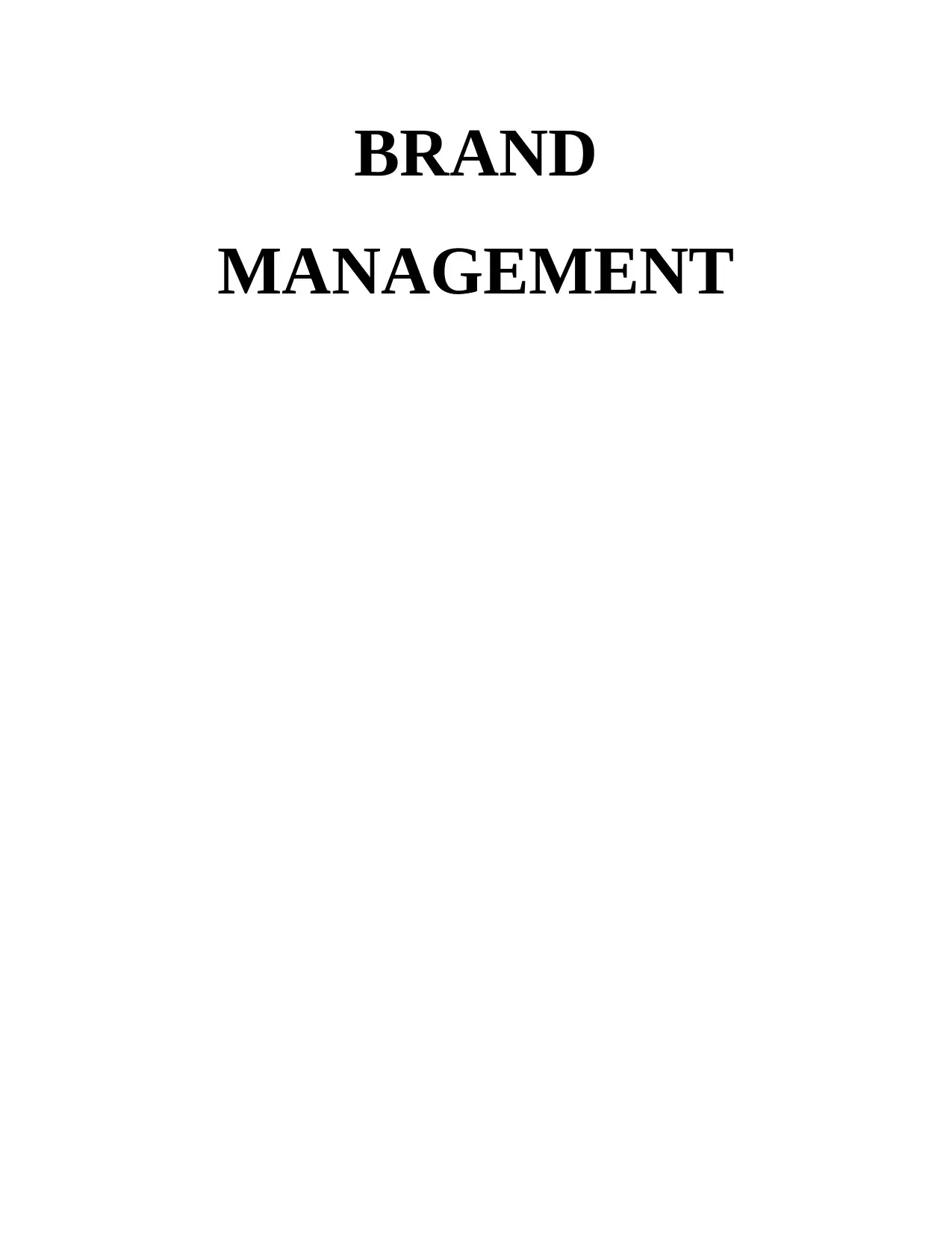
BRAND
MANAGEMENT
MANAGEMENT
Paraphrase This Document
Need a fresh take? Get an instant paraphrase of this document with our AI Paraphraser
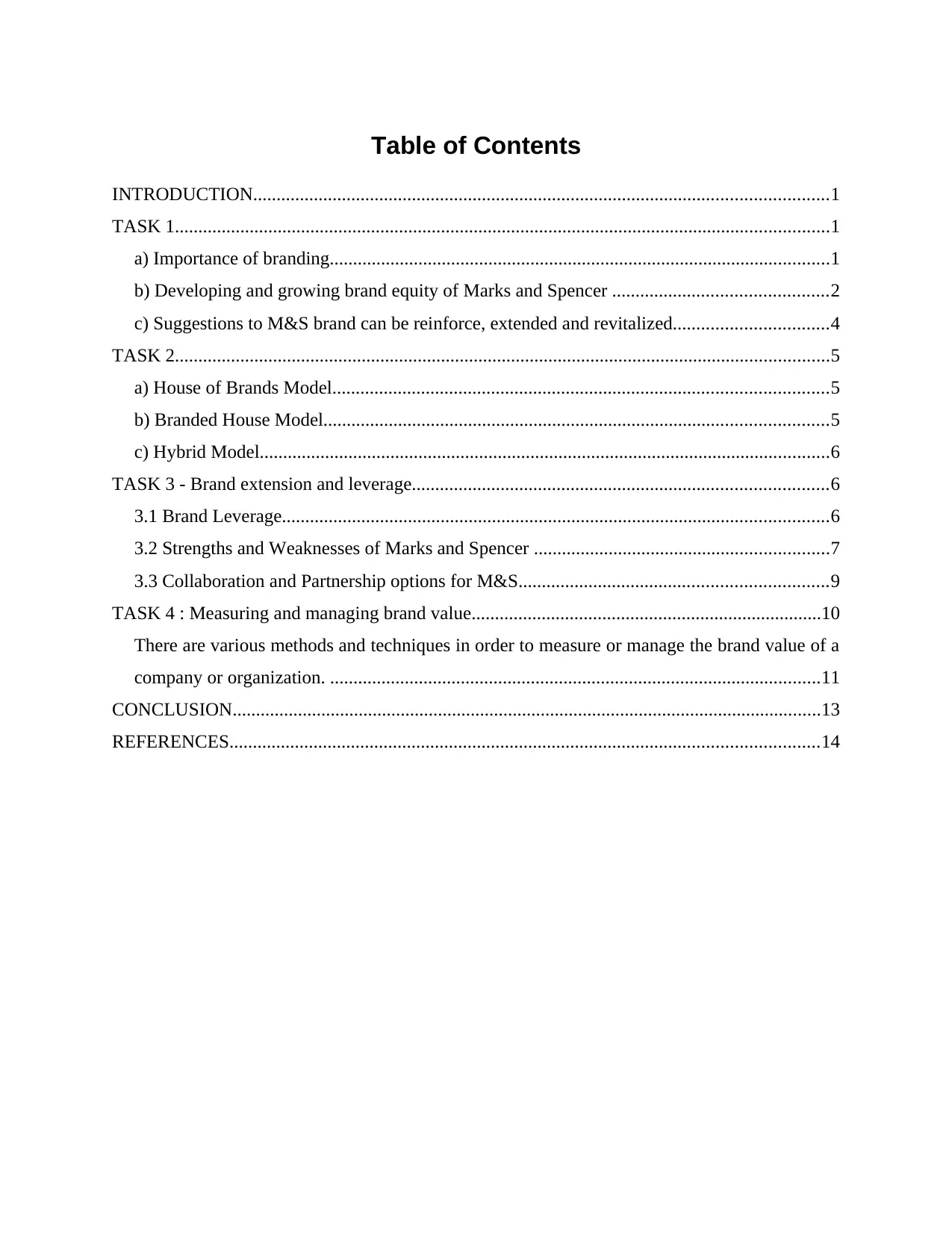
Table of Contents
INTRODUCTION...........................................................................................................................1
TASK 1............................................................................................................................................1
a) Importance of branding...........................................................................................................1
b) Developing and growing brand equity of Marks and Spencer ..............................................2
c) Suggestions to M&S brand can be reinforce, extended and revitalized.................................4
TASK 2............................................................................................................................................5
a) House of Brands Model..........................................................................................................5
b) Branded House Model............................................................................................................5
c) Hybrid Model..........................................................................................................................6
TASK 3 - Brand extension and leverage.........................................................................................6
3.1 Brand Leverage.....................................................................................................................6
3.2 Strengths and Weaknesses of Marks and Spencer ...............................................................7
3.3 Collaboration and Partnership options for M&S..................................................................9
TASK 4 : Measuring and managing brand value...........................................................................10
There are various methods and techniques in order to measure or manage the brand value of a
company or organization. .........................................................................................................11
CONCLUSION..............................................................................................................................13
REFERENCES..............................................................................................................................14
INTRODUCTION...........................................................................................................................1
TASK 1............................................................................................................................................1
a) Importance of branding...........................................................................................................1
b) Developing and growing brand equity of Marks and Spencer ..............................................2
c) Suggestions to M&S brand can be reinforce, extended and revitalized.................................4
TASK 2............................................................................................................................................5
a) House of Brands Model..........................................................................................................5
b) Branded House Model............................................................................................................5
c) Hybrid Model..........................................................................................................................6
TASK 3 - Brand extension and leverage.........................................................................................6
3.1 Brand Leverage.....................................................................................................................6
3.2 Strengths and Weaknesses of Marks and Spencer ...............................................................7
3.3 Collaboration and Partnership options for M&S..................................................................9
TASK 4 : Measuring and managing brand value...........................................................................10
There are various methods and techniques in order to measure or manage the brand value of a
company or organization. .........................................................................................................11
CONCLUSION..............................................................................................................................13
REFERENCES..............................................................................................................................14
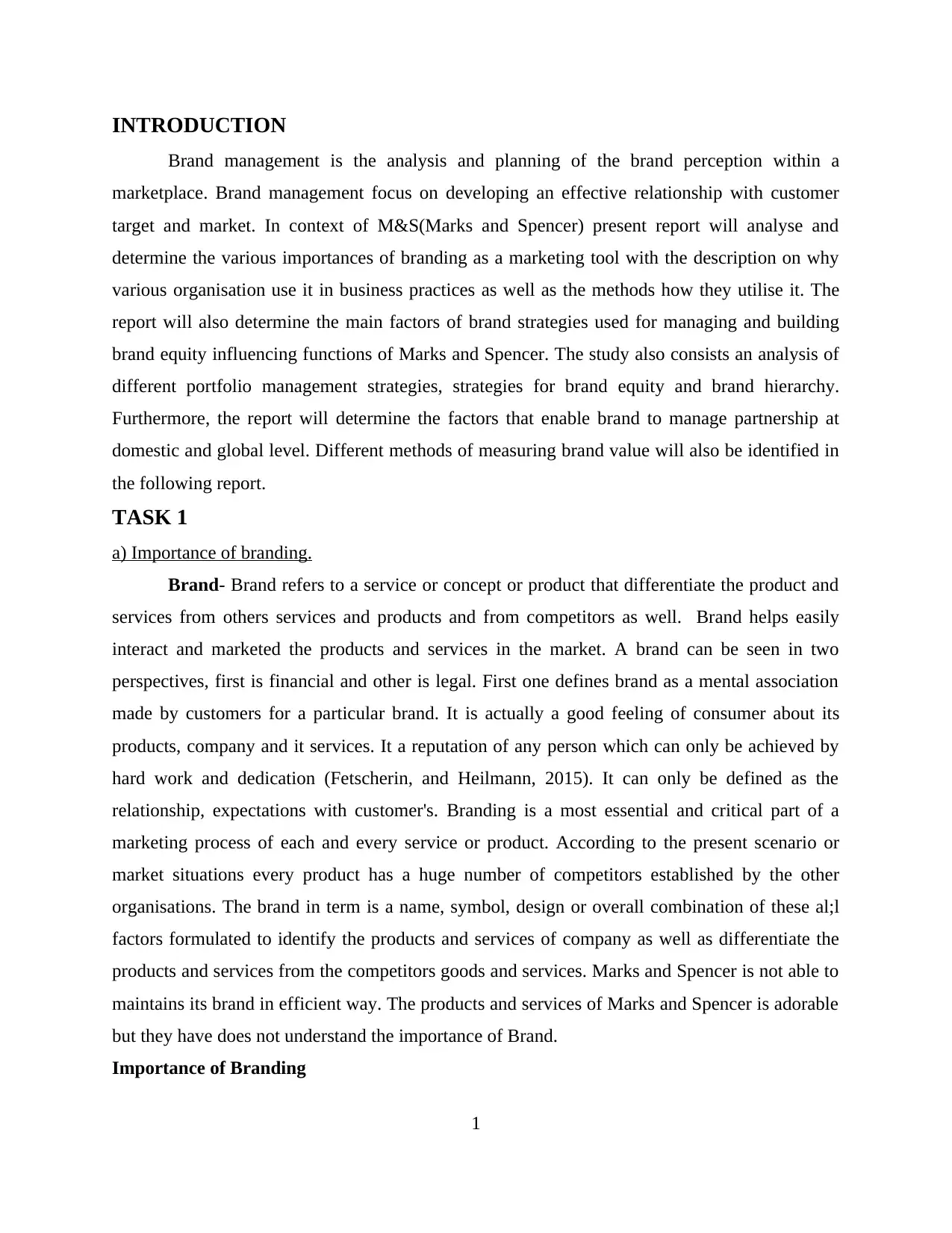
INTRODUCTION
Brand management is the analysis and planning of the brand perception within a
marketplace. Brand management focus on developing an effective relationship with customer
target and market. In context of M&S(Marks and Spencer) present report will analyse and
determine the various importances of branding as a marketing tool with the description on why
various organisation use it in business practices as well as the methods how they utilise it. The
report will also determine the main factors of brand strategies used for managing and building
brand equity influencing functions of Marks and Spencer. The study also consists an analysis of
different portfolio management strategies, strategies for brand equity and brand hierarchy.
Furthermore, the report will determine the factors that enable brand to manage partnership at
domestic and global level. Different methods of measuring brand value will also be identified in
the following report.
TASK 1
a) Importance of branding.
Brand- Brand refers to a service or concept or product that differentiate the product and
services from others services and products and from competitors as well. Brand helps easily
interact and marketed the products and services in the market. A brand can be seen in two
perspectives, first is financial and other is legal. First one defines brand as a mental association
made by customers for a particular brand. It is actually a good feeling of consumer about its
products, company and it services. It a reputation of any person which can only be achieved by
hard work and dedication (Fetscherin, and Heilmann, 2015). It can only be defined as the
relationship, expectations with customer's. Branding is a most essential and critical part of a
marketing process of each and every service or product. According to the present scenario or
market situations every product has a huge number of competitors established by the other
organisations. The brand in term is a name, symbol, design or overall combination of these al;l
factors formulated to identify the products and services of company as well as differentiate the
products and services from the competitors goods and services. Marks and Spencer is not able to
maintains its brand in efficient way. The products and services of Marks and Spencer is adorable
but they have does not understand the importance of Brand.
Importance of Branding
1
Brand management is the analysis and planning of the brand perception within a
marketplace. Brand management focus on developing an effective relationship with customer
target and market. In context of M&S(Marks and Spencer) present report will analyse and
determine the various importances of branding as a marketing tool with the description on why
various organisation use it in business practices as well as the methods how they utilise it. The
report will also determine the main factors of brand strategies used for managing and building
brand equity influencing functions of Marks and Spencer. The study also consists an analysis of
different portfolio management strategies, strategies for brand equity and brand hierarchy.
Furthermore, the report will determine the factors that enable brand to manage partnership at
domestic and global level. Different methods of measuring brand value will also be identified in
the following report.
TASK 1
a) Importance of branding.
Brand- Brand refers to a service or concept or product that differentiate the product and
services from others services and products and from competitors as well. Brand helps easily
interact and marketed the products and services in the market. A brand can be seen in two
perspectives, first is financial and other is legal. First one defines brand as a mental association
made by customers for a particular brand. It is actually a good feeling of consumer about its
products, company and it services. It a reputation of any person which can only be achieved by
hard work and dedication (Fetscherin, and Heilmann, 2015). It can only be defined as the
relationship, expectations with customer's. Branding is a most essential and critical part of a
marketing process of each and every service or product. According to the present scenario or
market situations every product has a huge number of competitors established by the other
organisations. The brand in term is a name, symbol, design or overall combination of these al;l
factors formulated to identify the products and services of company as well as differentiate the
products and services from the competitors goods and services. Marks and Spencer is not able to
maintains its brand in efficient way. The products and services of Marks and Spencer is adorable
but they have does not understand the importance of Brand.
Importance of Branding
1
⊘ This is a preview!⊘
Do you want full access?
Subscribe today to unlock all pages.

Trusted by 1+ million students worldwide
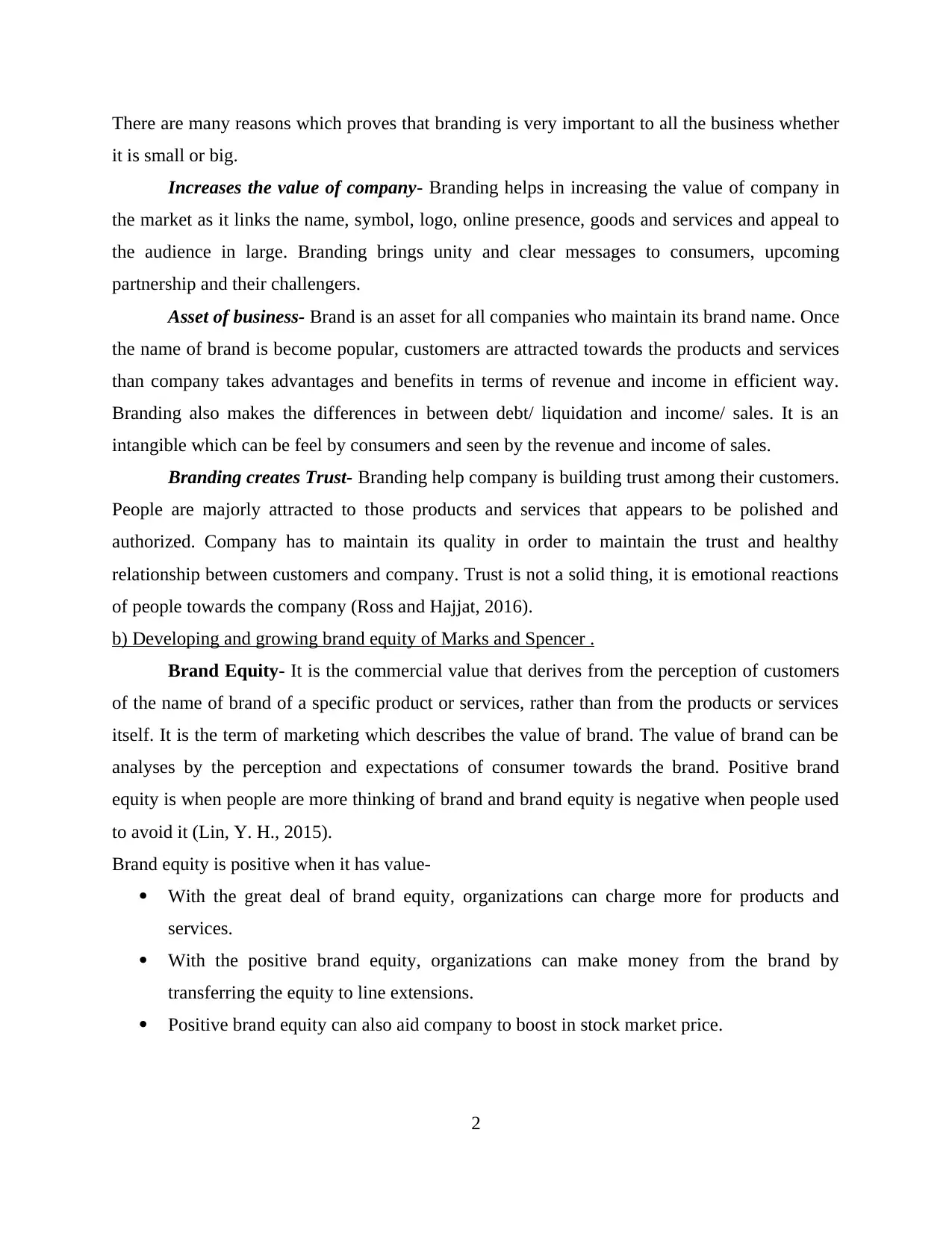
There are many reasons which proves that branding is very important to all the business whether
it is small or big.
Increases the value of company- Branding helps in increasing the value of company in
the market as it links the name, symbol, logo, online presence, goods and services and appeal to
the audience in large. Branding brings unity and clear messages to consumers, upcoming
partnership and their challengers.
Asset of business- Brand is an asset for all companies who maintain its brand name. Once
the name of brand is become popular, customers are attracted towards the products and services
than company takes advantages and benefits in terms of revenue and income in efficient way.
Branding also makes the differences in between debt/ liquidation and income/ sales. It is an
intangible which can be feel by consumers and seen by the revenue and income of sales.
Branding creates Trust- Branding help company is building trust among their customers.
People are majorly attracted to those products and services that appears to be polished and
authorized. Company has to maintain its quality in order to maintain the trust and healthy
relationship between customers and company. Trust is not a solid thing, it is emotional reactions
of people towards the company (Ross and Hajjat, 2016).
b) Developing and growing brand equity of Marks and Spencer .
Brand Equity- It is the commercial value that derives from the perception of customers
of the name of brand of a specific product or services, rather than from the products or services
itself. It is the term of marketing which describes the value of brand. The value of brand can be
analyses by the perception and expectations of consumer towards the brand. Positive brand
equity is when people are more thinking of brand and brand equity is negative when people used
to avoid it (Lin, Y. H., 2015).
Brand equity is positive when it has value-
With the great deal of brand equity, organizations can charge more for products and
services.
With the positive brand equity, organizations can make money from the brand by
transferring the equity to line extensions.
Positive brand equity can also aid company to boost in stock market price.
2
it is small or big.
Increases the value of company- Branding helps in increasing the value of company in
the market as it links the name, symbol, logo, online presence, goods and services and appeal to
the audience in large. Branding brings unity and clear messages to consumers, upcoming
partnership and their challengers.
Asset of business- Brand is an asset for all companies who maintain its brand name. Once
the name of brand is become popular, customers are attracted towards the products and services
than company takes advantages and benefits in terms of revenue and income in efficient way.
Branding also makes the differences in between debt/ liquidation and income/ sales. It is an
intangible which can be feel by consumers and seen by the revenue and income of sales.
Branding creates Trust- Branding help company is building trust among their customers.
People are majorly attracted to those products and services that appears to be polished and
authorized. Company has to maintain its quality in order to maintain the trust and healthy
relationship between customers and company. Trust is not a solid thing, it is emotional reactions
of people towards the company (Ross and Hajjat, 2016).
b) Developing and growing brand equity of Marks and Spencer .
Brand Equity- It is the commercial value that derives from the perception of customers
of the name of brand of a specific product or services, rather than from the products or services
itself. It is the term of marketing which describes the value of brand. The value of brand can be
analyses by the perception and expectations of consumer towards the brand. Positive brand
equity is when people are more thinking of brand and brand equity is negative when people used
to avoid it (Lin, Y. H., 2015).
Brand equity is positive when it has value-
With the great deal of brand equity, organizations can charge more for products and
services.
With the positive brand equity, organizations can make money from the brand by
transferring the equity to line extensions.
Positive brand equity can also aid company to boost in stock market price.
2
Paraphrase This Document
Need a fresh take? Get an instant paraphrase of this document with our AI Paraphraser
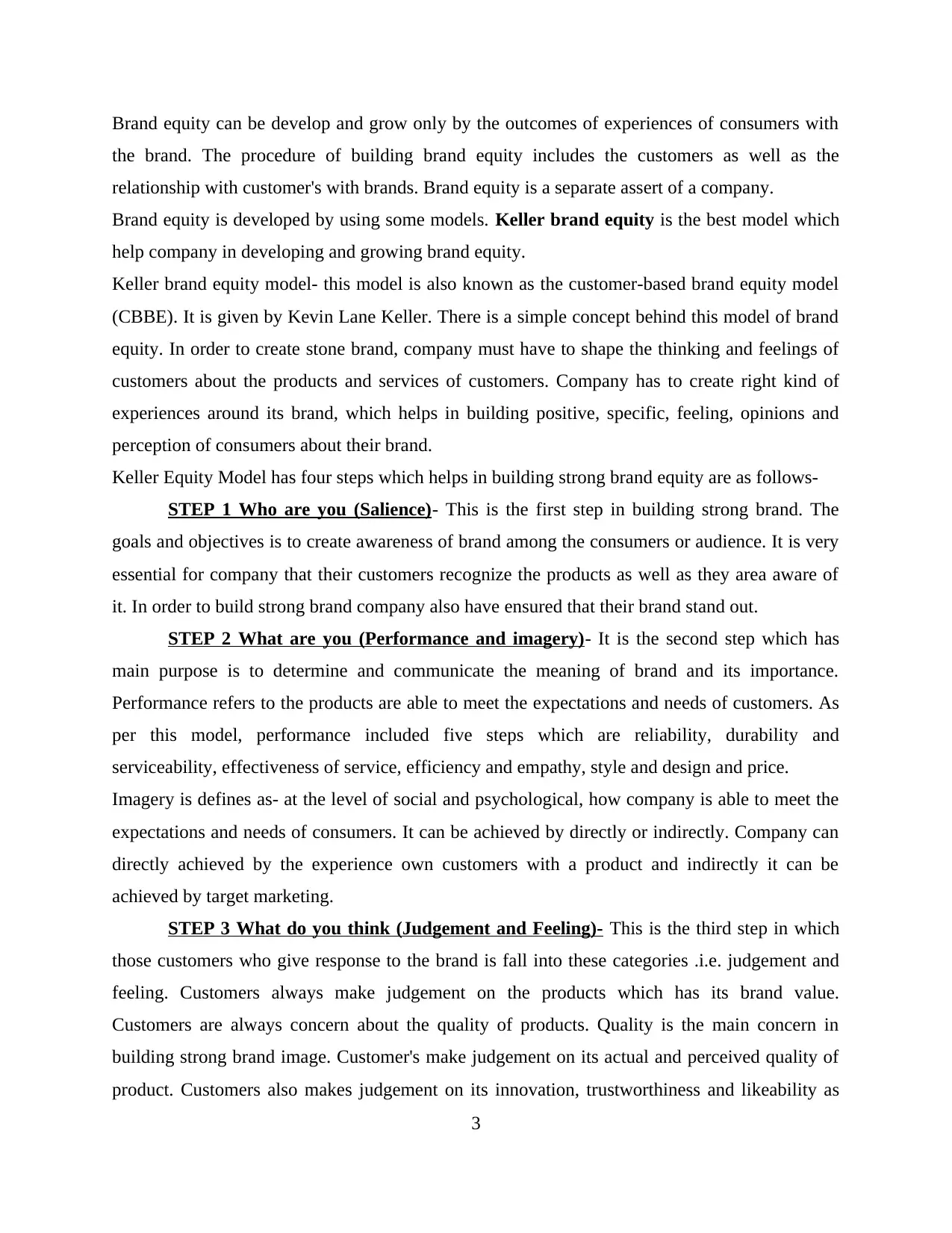
Brand equity can be develop and grow only by the outcomes of experiences of consumers with
the brand. The procedure of building brand equity includes the customers as well as the
relationship with customer's with brands. Brand equity is a separate assert of a company.
Brand equity is developed by using some models. Keller brand equity is the best model which
help company in developing and growing brand equity.
Keller brand equity model- this model is also known as the customer-based brand equity model
(CBBE). It is given by Kevin Lane Keller. There is a simple concept behind this model of brand
equity. In order to create stone brand, company must have to shape the thinking and feelings of
customers about the products and services of customers. Company has to create right kind of
experiences around its brand, which helps in building positive, specific, feeling, opinions and
perception of consumers about their brand.
Keller Equity Model has four steps which helps in building strong brand equity are as follows-
STEP 1 Who are you (Salience)- This is the first step in building strong brand. The
goals and objectives is to create awareness of brand among the consumers or audience. It is very
essential for company that their customers recognize the products as well as they area aware of
it. In order to build strong brand company also have ensured that their brand stand out.
STEP 2 What are you (Performance and imagery)- It is the second step which has
main purpose is to determine and communicate the meaning of brand and its importance.
Performance refers to the products are able to meet the expectations and needs of customers. As
per this model, performance included five steps which are reliability, durability and
serviceability, effectiveness of service, efficiency and empathy, style and design and price.
Imagery is defines as- at the level of social and psychological, how company is able to meet the
expectations and needs of consumers. It can be achieved by directly or indirectly. Company can
directly achieved by the experience own customers with a product and indirectly it can be
achieved by target marketing.
STEP 3 What do you think (Judgement and Feeling)- This is the third step in which
those customers who give response to the brand is fall into these categories .i.e. judgement and
feeling. Customers always make judgement on the products which has its brand value.
Customers are always concern about the quality of products. Quality is the main concern in
building strong brand image. Customer's make judgement on its actual and perceived quality of
product. Customers also makes judgement on its innovation, trustworthiness and likeability as
3
the brand. The procedure of building brand equity includes the customers as well as the
relationship with customer's with brands. Brand equity is a separate assert of a company.
Brand equity is developed by using some models. Keller brand equity is the best model which
help company in developing and growing brand equity.
Keller brand equity model- this model is also known as the customer-based brand equity model
(CBBE). It is given by Kevin Lane Keller. There is a simple concept behind this model of brand
equity. In order to create stone brand, company must have to shape the thinking and feelings of
customers about the products and services of customers. Company has to create right kind of
experiences around its brand, which helps in building positive, specific, feeling, opinions and
perception of consumers about their brand.
Keller Equity Model has four steps which helps in building strong brand equity are as follows-
STEP 1 Who are you (Salience)- This is the first step in building strong brand. The
goals and objectives is to create awareness of brand among the consumers or audience. It is very
essential for company that their customers recognize the products as well as they area aware of
it. In order to build strong brand company also have ensured that their brand stand out.
STEP 2 What are you (Performance and imagery)- It is the second step which has
main purpose is to determine and communicate the meaning of brand and its importance.
Performance refers to the products are able to meet the expectations and needs of customers. As
per this model, performance included five steps which are reliability, durability and
serviceability, effectiveness of service, efficiency and empathy, style and design and price.
Imagery is defines as- at the level of social and psychological, how company is able to meet the
expectations and needs of consumers. It can be achieved by directly or indirectly. Company can
directly achieved by the experience own customers with a product and indirectly it can be
achieved by target marketing.
STEP 3 What do you think (Judgement and Feeling)- This is the third step in which
those customers who give response to the brand is fall into these categories .i.e. judgement and
feeling. Customers always make judgement on the products which has its brand value.
Customers are always concern about the quality of products. Quality is the main concern in
building strong brand image. Customer's make judgement on its actual and perceived quality of
product. Customers also makes judgement on its innovation, trustworthiness and likeability as
3
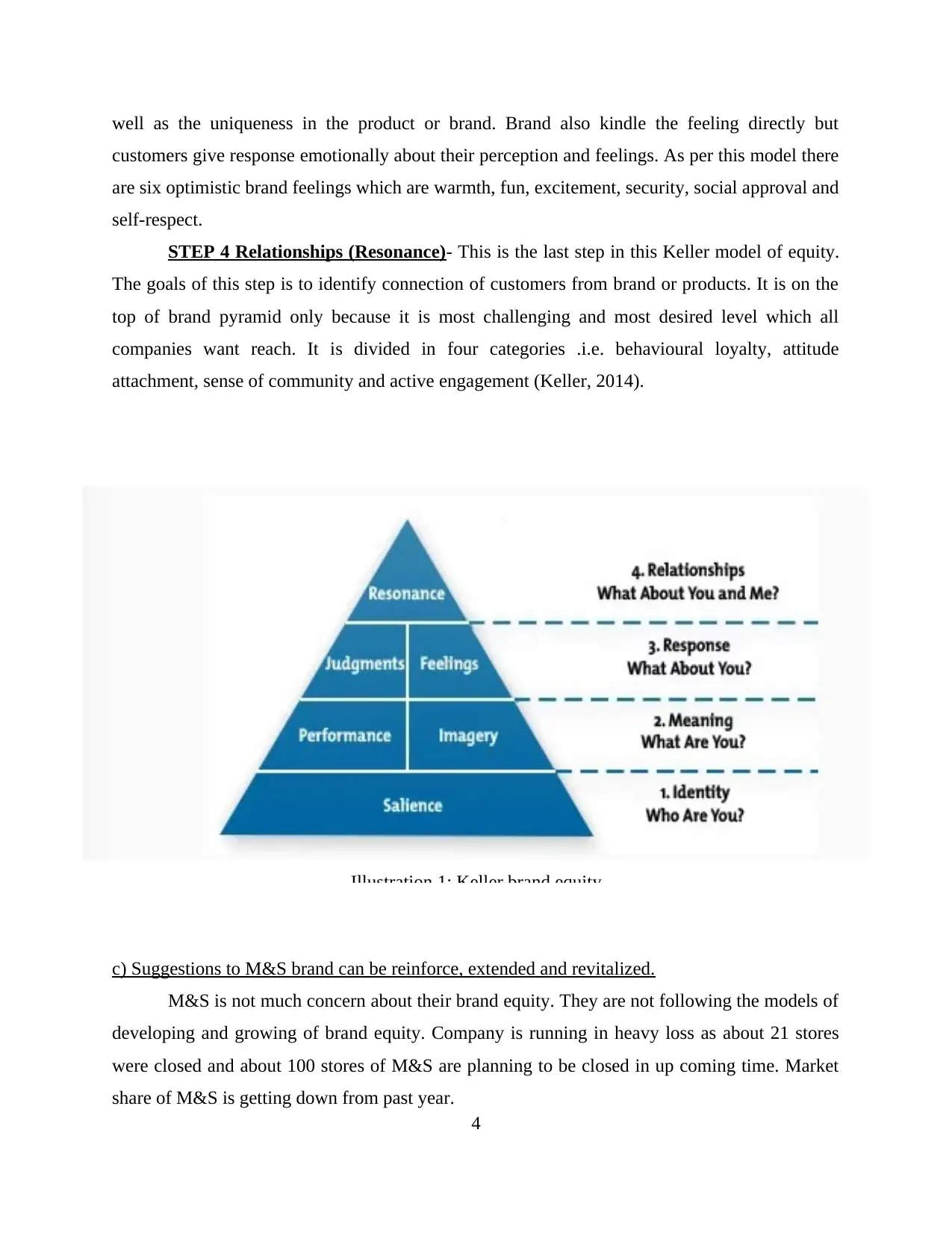
well as the uniqueness in the product or brand. Brand also kindle the feeling directly but
customers give response emotionally about their perception and feelings. As per this model there
are six optimistic brand feelings which are warmth, fun, excitement, security, social approval and
self-respect.
STEP 4 Relationships (Resonance)- This is the last step in this Keller model of equity.
The goals of this step is to identify connection of customers from brand or products. It is on the
top of brand pyramid only because it is most challenging and most desired level which all
companies want reach. It is divided in four categories .i.e. behavioural loyalty, attitude
attachment, sense of community and active engagement (Keller, 2014).
c) Suggestions to M&S brand can be reinforce, extended and revitalized.
M&S is not much concern about their brand equity. They are not following the models of
developing and growing of brand equity. Company is running in heavy loss as about 21 stores
were closed and about 100 stores of M&S are planning to be closed in up coming time. Market
share of M&S is getting down from past year.
4
Illustration 1: Keller brand equity
customers give response emotionally about their perception and feelings. As per this model there
are six optimistic brand feelings which are warmth, fun, excitement, security, social approval and
self-respect.
STEP 4 Relationships (Resonance)- This is the last step in this Keller model of equity.
The goals of this step is to identify connection of customers from brand or products. It is on the
top of brand pyramid only because it is most challenging and most desired level which all
companies want reach. It is divided in four categories .i.e. behavioural loyalty, attitude
attachment, sense of community and active engagement (Keller, 2014).
c) Suggestions to M&S brand can be reinforce, extended and revitalized.
M&S is not much concern about their brand equity. They are not following the models of
developing and growing of brand equity. Company is running in heavy loss as about 21 stores
were closed and about 100 stores of M&S are planning to be closed in up coming time. Market
share of M&S is getting down from past year.
4
Illustration 1: Keller brand equity
⊘ This is a preview!⊘
Do you want full access?
Subscribe today to unlock all pages.

Trusted by 1+ million students worldwide
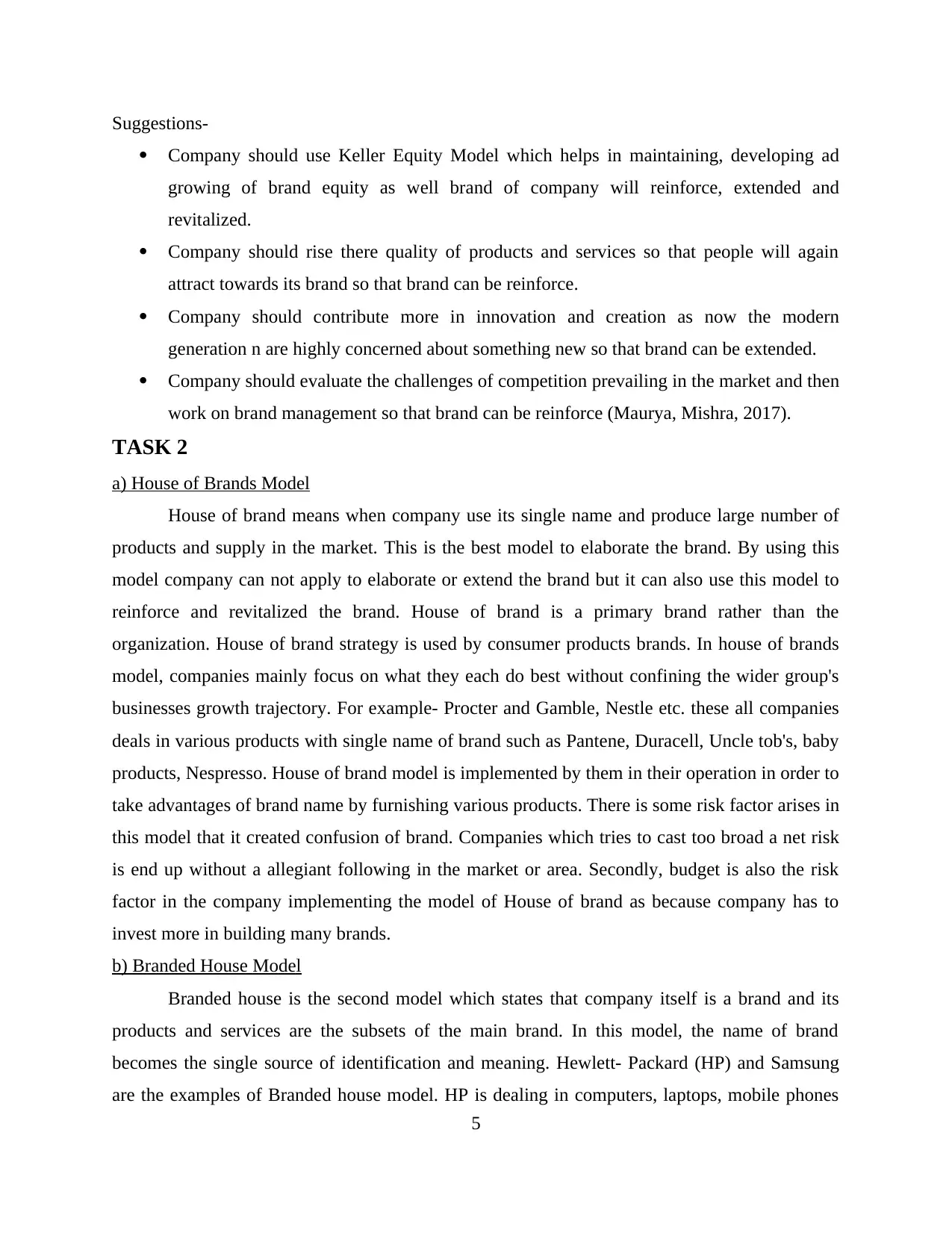
Suggestions-
Company should use Keller Equity Model which helps in maintaining, developing ad
growing of brand equity as well brand of company will reinforce, extended and
revitalized.
Company should rise there quality of products and services so that people will again
attract towards its brand so that brand can be reinforce.
Company should contribute more in innovation and creation as now the modern
generation n are highly concerned about something new so that brand can be extended.
Company should evaluate the challenges of competition prevailing in the market and then
work on brand management so that brand can be reinforce (Maurya, Mishra, 2017).
TASK 2
a) House of Brands Model
House of brand means when company use its single name and produce large number of
products and supply in the market. This is the best model to elaborate the brand. By using this
model company can not apply to elaborate or extend the brand but it can also use this model to
reinforce and revitalized the brand. House of brand is a primary brand rather than the
organization. House of brand strategy is used by consumer products brands. In house of brands
model, companies mainly focus on what they each do best without confining the wider group's
businesses growth trajectory. For example- Procter and Gamble, Nestle etc. these all companies
deals in various products with single name of brand such as Pantene, Duracell, Uncle tob's, baby
products, Nespresso. House of brand model is implemented by them in their operation in order to
take advantages of brand name by furnishing various products. There is some risk factor arises in
this model that it created confusion of brand. Companies which tries to cast too broad a net risk
is end up without a allegiant following in the market or area. Secondly, budget is also the risk
factor in the company implementing the model of House of brand as because company has to
invest more in building many brands.
b) Branded House Model
Branded house is the second model which states that company itself is a brand and its
products and services are the subsets of the main brand. In this model, the name of brand
becomes the single source of identification and meaning. Hewlett- Packard (HP) and Samsung
are the examples of Branded house model. HP is dealing in computers, laptops, mobile phones
5
Company should use Keller Equity Model which helps in maintaining, developing ad
growing of brand equity as well brand of company will reinforce, extended and
revitalized.
Company should rise there quality of products and services so that people will again
attract towards its brand so that brand can be reinforce.
Company should contribute more in innovation and creation as now the modern
generation n are highly concerned about something new so that brand can be extended.
Company should evaluate the challenges of competition prevailing in the market and then
work on brand management so that brand can be reinforce (Maurya, Mishra, 2017).
TASK 2
a) House of Brands Model
House of brand means when company use its single name and produce large number of
products and supply in the market. This is the best model to elaborate the brand. By using this
model company can not apply to elaborate or extend the brand but it can also use this model to
reinforce and revitalized the brand. House of brand is a primary brand rather than the
organization. House of brand strategy is used by consumer products brands. In house of brands
model, companies mainly focus on what they each do best without confining the wider group's
businesses growth trajectory. For example- Procter and Gamble, Nestle etc. these all companies
deals in various products with single name of brand such as Pantene, Duracell, Uncle tob's, baby
products, Nespresso. House of brand model is implemented by them in their operation in order to
take advantages of brand name by furnishing various products. There is some risk factor arises in
this model that it created confusion of brand. Companies which tries to cast too broad a net risk
is end up without a allegiant following in the market or area. Secondly, budget is also the risk
factor in the company implementing the model of House of brand as because company has to
invest more in building many brands.
b) Branded House Model
Branded house is the second model which states that company itself is a brand and its
products and services are the subsets of the main brand. In this model, the name of brand
becomes the single source of identification and meaning. Hewlett- Packard (HP) and Samsung
are the examples of Branded house model. HP is dealing in computers, laptops, mobile phones
5
Paraphrase This Document
Need a fresh take? Get an instant paraphrase of this document with our AI Paraphraser
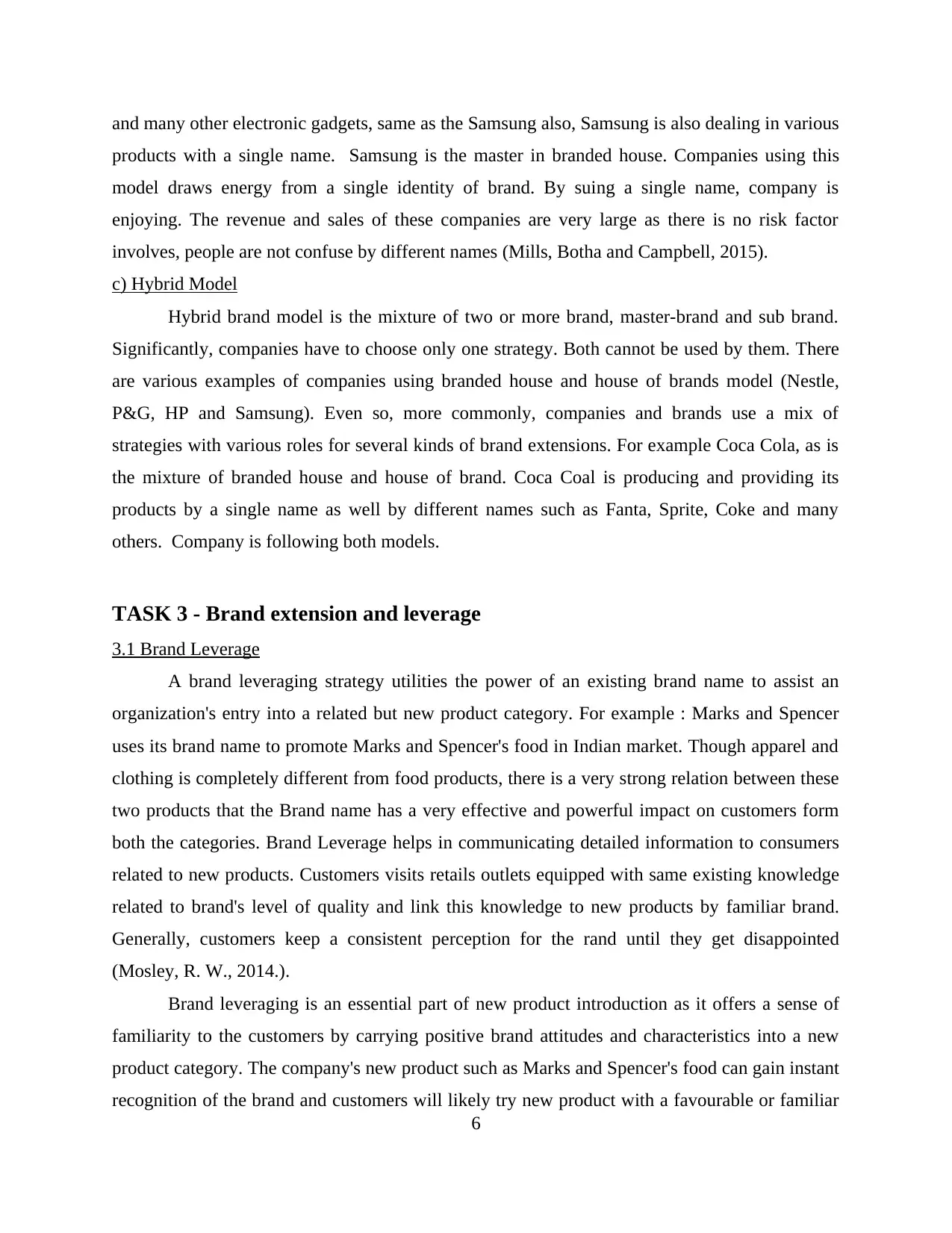
and many other electronic gadgets, same as the Samsung also, Samsung is also dealing in various
products with a single name. Samsung is the master in branded house. Companies using this
model draws energy from a single identity of brand. By suing a single name, company is
enjoying. The revenue and sales of these companies are very large as there is no risk factor
involves, people are not confuse by different names (Mills, Botha and Campbell, 2015).
c) Hybrid Model
Hybrid brand model is the mixture of two or more brand, master-brand and sub brand.
Significantly, companies have to choose only one strategy. Both cannot be used by them. There
are various examples of companies using branded house and house of brands model (Nestle,
P&G, HP and Samsung). Even so, more commonly, companies and brands use a mix of
strategies with various roles for several kinds of brand extensions. For example Coca Cola, as is
the mixture of branded house and house of brand. Coca Coal is producing and providing its
products by a single name as well by different names such as Fanta, Sprite, Coke and many
others. Company is following both models.
TASK 3 - Brand extension and leverage
3.1 Brand Leverage
A brand leveraging strategy utilities the power of an existing brand name to assist an
organization's entry into a related but new product category. For example : Marks and Spencer
uses its brand name to promote Marks and Spencer's food in Indian market. Though apparel and
clothing is completely different from food products, there is a very strong relation between these
two products that the Brand name has a very effective and powerful impact on customers form
both the categories. Brand Leverage helps in communicating detailed information to consumers
related to new products. Customers visits retails outlets equipped with same existing knowledge
related to brand's level of quality and link this knowledge to new products by familiar brand.
Generally, customers keep a consistent perception for the rand until they get disappointed
(Mosley, R. W., 2014.).
Brand leveraging is an essential part of new product introduction as it offers a sense of
familiarity to the customers by carrying positive brand attitudes and characteristics into a new
product category. The company's new product such as Marks and Spencer's food can gain instant
recognition of the brand and customers will likely try new product with a favourable or familiar
6
products with a single name. Samsung is the master in branded house. Companies using this
model draws energy from a single identity of brand. By suing a single name, company is
enjoying. The revenue and sales of these companies are very large as there is no risk factor
involves, people are not confuse by different names (Mills, Botha and Campbell, 2015).
c) Hybrid Model
Hybrid brand model is the mixture of two or more brand, master-brand and sub brand.
Significantly, companies have to choose only one strategy. Both cannot be used by them. There
are various examples of companies using branded house and house of brands model (Nestle,
P&G, HP and Samsung). Even so, more commonly, companies and brands use a mix of
strategies with various roles for several kinds of brand extensions. For example Coca Cola, as is
the mixture of branded house and house of brand. Coca Coal is producing and providing its
products by a single name as well by different names such as Fanta, Sprite, Coke and many
others. Company is following both models.
TASK 3 - Brand extension and leverage
3.1 Brand Leverage
A brand leveraging strategy utilities the power of an existing brand name to assist an
organization's entry into a related but new product category. For example : Marks and Spencer
uses its brand name to promote Marks and Spencer's food in Indian market. Though apparel and
clothing is completely different from food products, there is a very strong relation between these
two products that the Brand name has a very effective and powerful impact on customers form
both the categories. Brand Leverage helps in communicating detailed information to consumers
related to new products. Customers visits retails outlets equipped with same existing knowledge
related to brand's level of quality and link this knowledge to new products by familiar brand.
Generally, customers keep a consistent perception for the rand until they get disappointed
(Mosley, R. W., 2014.).
Brand leveraging is an essential part of new product introduction as it offers a sense of
familiarity to the customers by carrying positive brand attitudes and characteristics into a new
product category. The company's new product such as Marks and Spencer's food can gain instant
recognition of the brand and customers will likely try new product with a favourable or familiar
6
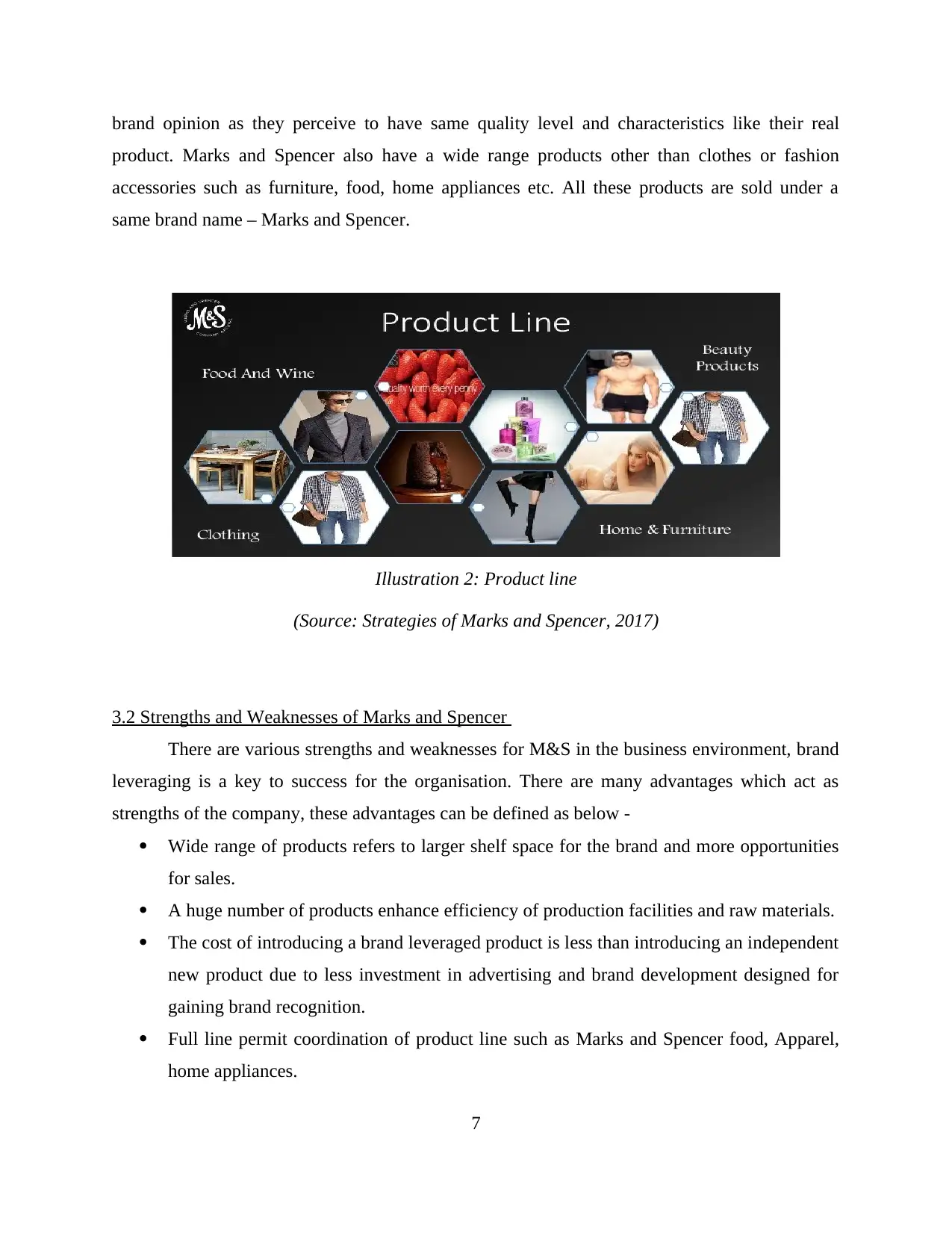
brand opinion as they perceive to have same quality level and characteristics like their real
product. Marks and Spencer also have a wide range products other than clothes or fashion
accessories such as furniture, food, home appliances etc. All these products are sold under a
same brand name – Marks and Spencer.
3.2 Strengths and Weaknesses of Marks and Spencer
There are various strengths and weaknesses for M&S in the business environment, brand
leveraging is a key to success for the organisation. There are many advantages which act as
strengths of the company, these advantages can be defined as below -
Wide range of products refers to larger shelf space for the brand and more opportunities
for sales.
A huge number of products enhance efficiency of production facilities and raw materials.
The cost of introducing a brand leveraged product is less than introducing an independent
new product due to less investment in advertising and brand development designed for
gaining brand recognition.
Full line permit coordination of product line such as Marks and Spencer food, Apparel,
home appliances.
7
Illustration 2: Product line
(Source: Strategies of Marks and Spencer, 2017)
product. Marks and Spencer also have a wide range products other than clothes or fashion
accessories such as furniture, food, home appliances etc. All these products are sold under a
same brand name – Marks and Spencer.
3.2 Strengths and Weaknesses of Marks and Spencer
There are various strengths and weaknesses for M&S in the business environment, brand
leveraging is a key to success for the organisation. There are many advantages which act as
strengths of the company, these advantages can be defined as below -
Wide range of products refers to larger shelf space for the brand and more opportunities
for sales.
A huge number of products enhance efficiency of production facilities and raw materials.
The cost of introducing a brand leveraged product is less than introducing an independent
new product due to less investment in advertising and brand development designed for
gaining brand recognition.
Full line permit coordination of product line such as Marks and Spencer food, Apparel,
home appliances.
7
Illustration 2: Product line
(Source: Strategies of Marks and Spencer, 2017)
⊘ This is a preview!⊘
Do you want full access?
Subscribe today to unlock all pages.

Trusted by 1+ million students worldwide
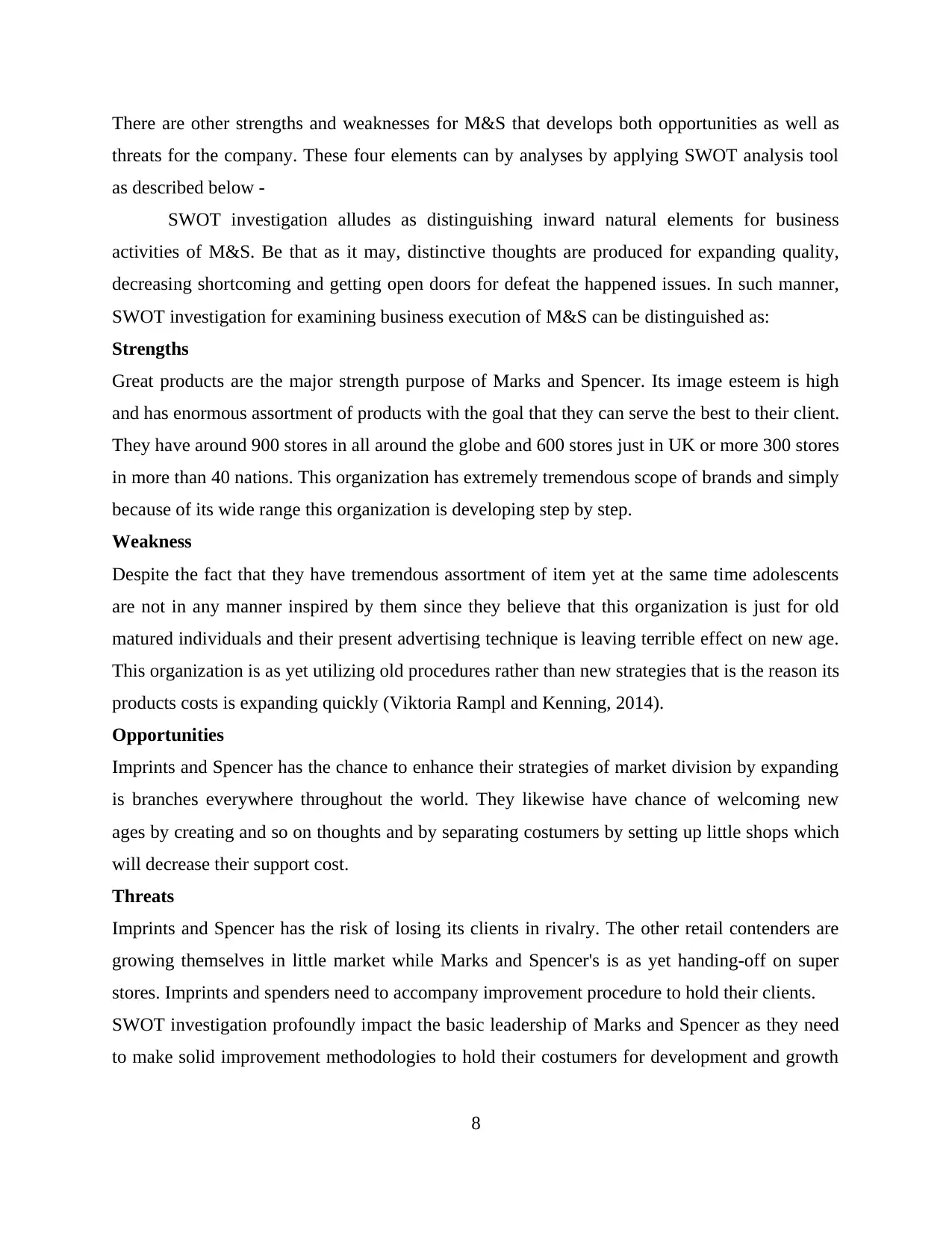
There are other strengths and weaknesses for M&S that develops both opportunities as well as
threats for the company. These four elements can by analyses by applying SWOT analysis tool
as described below -
SWOT investigation alludes as distinguishing inward natural elements for business
activities of M&S. Be that as it may, distinctive thoughts are produced for expanding quality,
decreasing shortcoming and getting open doors for defeat the happened issues. In such manner,
SWOT investigation for examining business execution of M&S can be distinguished as:
Strengths
Great products are the major strength purpose of Marks and Spencer. Its image esteem is high
and has enormous assortment of products with the goal that they can serve the best to their client.
They have around 900 stores in all around the globe and 600 stores just in UK or more 300 stores
in more than 40 nations. This organization has extremely tremendous scope of brands and simply
because of its wide range this organization is developing step by step.
Weakness
Despite the fact that they have tremendous assortment of item yet at the same time adolescents
are not in any manner inspired by them since they believe that this organization is just for old
matured individuals and their present advertising technique is leaving terrible effect on new age.
This organization is as yet utilizing old procedures rather than new strategies that is the reason its
products costs is expanding quickly (Viktoria Rampl and Kenning, 2014).
Opportunities
Imprints and Spencer has the chance to enhance their strategies of market division by expanding
is branches everywhere throughout the world. They likewise have chance of welcoming new
ages by creating and so on thoughts and by separating costumers by setting up little shops which
will decrease their support cost.
Threats
Imprints and Spencer has the risk of losing its clients in rivalry. The other retail contenders are
growing themselves in little market while Marks and Spencer's is as yet handing-off on super
stores. Imprints and spenders need to accompany improvement procedure to hold their clients.
SWOT investigation profoundly impact the basic leadership of Marks and Spencer as they need
to make solid improvement methodologies to hold their costumers for development and growth
8
threats for the company. These four elements can by analyses by applying SWOT analysis tool
as described below -
SWOT investigation alludes as distinguishing inward natural elements for business
activities of M&S. Be that as it may, distinctive thoughts are produced for expanding quality,
decreasing shortcoming and getting open doors for defeat the happened issues. In such manner,
SWOT investigation for examining business execution of M&S can be distinguished as:
Strengths
Great products are the major strength purpose of Marks and Spencer. Its image esteem is high
and has enormous assortment of products with the goal that they can serve the best to their client.
They have around 900 stores in all around the globe and 600 stores just in UK or more 300 stores
in more than 40 nations. This organization has extremely tremendous scope of brands and simply
because of its wide range this organization is developing step by step.
Weakness
Despite the fact that they have tremendous assortment of item yet at the same time adolescents
are not in any manner inspired by them since they believe that this organization is just for old
matured individuals and their present advertising technique is leaving terrible effect on new age.
This organization is as yet utilizing old procedures rather than new strategies that is the reason its
products costs is expanding quickly (Viktoria Rampl and Kenning, 2014).
Opportunities
Imprints and Spencer has the chance to enhance their strategies of market division by expanding
is branches everywhere throughout the world. They likewise have chance of welcoming new
ages by creating and so on thoughts and by separating costumers by setting up little shops which
will decrease their support cost.
Threats
Imprints and Spencer has the risk of losing its clients in rivalry. The other retail contenders are
growing themselves in little market while Marks and Spencer's is as yet handing-off on super
stores. Imprints and spenders need to accompany improvement procedure to hold their clients.
SWOT investigation profoundly impact the basic leadership of Marks and Spencer as they need
to make solid improvement methodologies to hold their costumers for development and growth
8
Paraphrase This Document
Need a fresh take? Get an instant paraphrase of this document with our AI Paraphraser
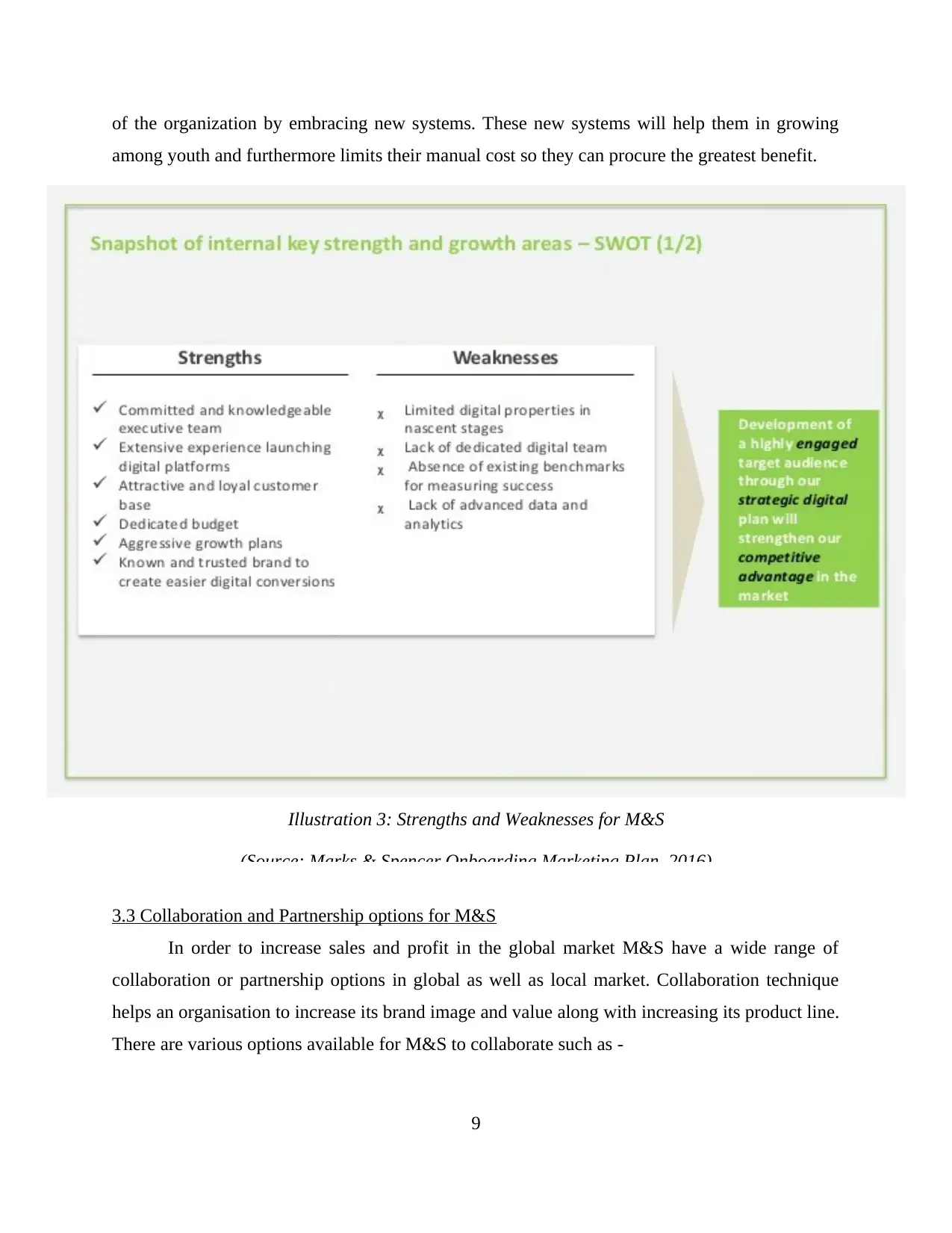
of the organization by embracing new systems. These new systems will help them in growing
among youth and furthermore limits their manual cost so they can procure the greatest benefit.
3.3 Collaboration and Partnership options for M&S
In order to increase sales and profit in the global market M&S have a wide range of
collaboration or partnership options in global as well as local market. Collaboration technique
helps an organisation to increase its brand image and value along with increasing its product line.
There are various options available for M&S to collaborate such as -
9
Illustration 3: Strengths and Weaknesses for M&S
(Source: Marks & Spencer Onboarding Marketing Plan, 2016)
among youth and furthermore limits their manual cost so they can procure the greatest benefit.
3.3 Collaboration and Partnership options for M&S
In order to increase sales and profit in the global market M&S have a wide range of
collaboration or partnership options in global as well as local market. Collaboration technique
helps an organisation to increase its brand image and value along with increasing its product line.
There are various options available for M&S to collaborate such as -
9
Illustration 3: Strengths and Weaknesses for M&S
(Source: Marks & Spencer Onboarding Marketing Plan, 2016)
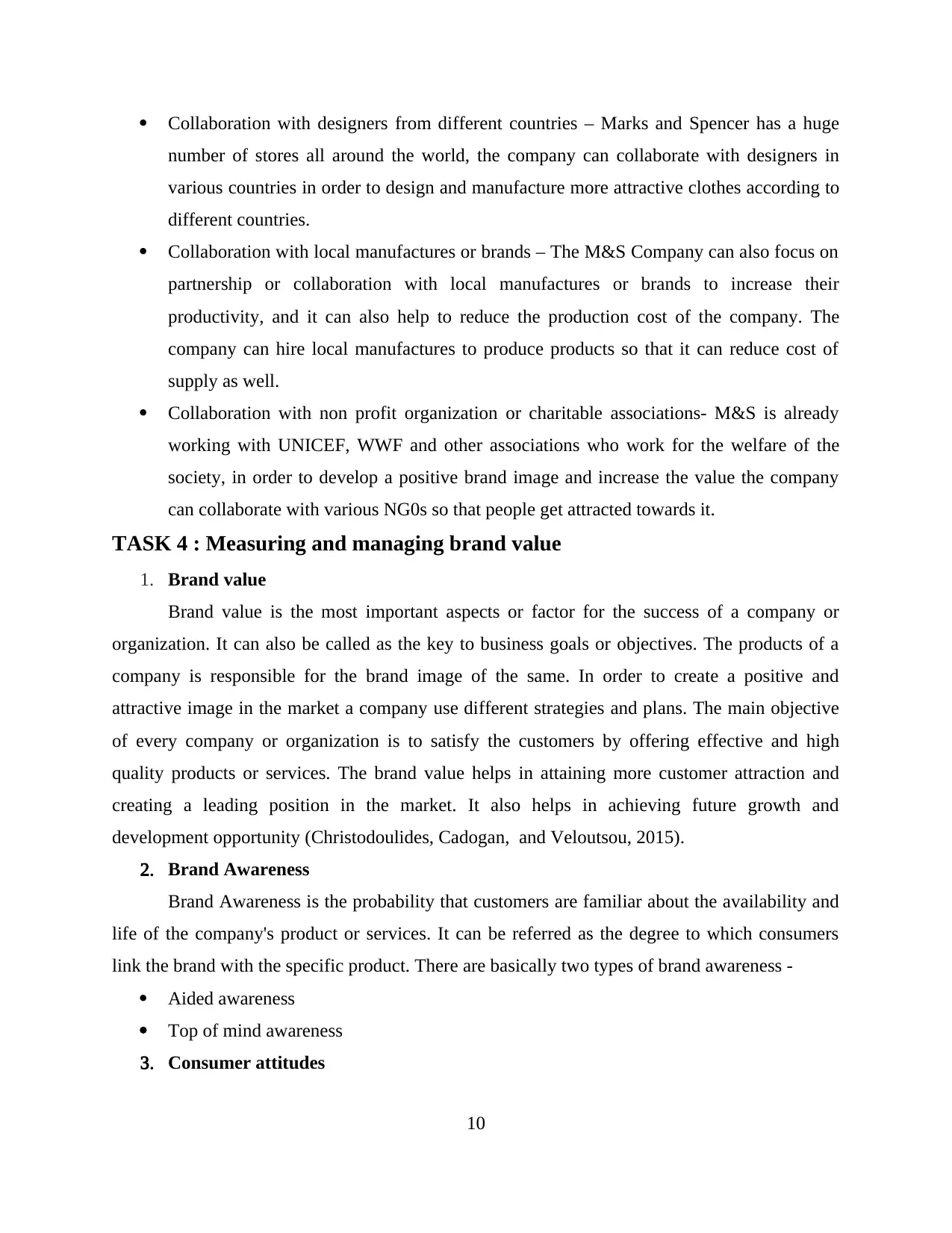
Collaboration with designers from different countries – Marks and Spencer has a huge
number of stores all around the world, the company can collaborate with designers in
various countries in order to design and manufacture more attractive clothes according to
different countries.
Collaboration with local manufactures or brands – The M&S Company can also focus on
partnership or collaboration with local manufactures or brands to increase their
productivity, and it can also help to reduce the production cost of the company. The
company can hire local manufactures to produce products so that it can reduce cost of
supply as well.
Collaboration with non profit organization or charitable associations- M&S is already
working with UNICEF, WWF and other associations who work for the welfare of the
society, in order to develop a positive brand image and increase the value the company
can collaborate with various NG0s so that people get attracted towards it.
TASK 4 : Measuring and managing brand value
1. Brand value
Brand value is the most important aspects or factor for the success of a company or
organization. It can also be called as the key to business goals or objectives. The products of a
company is responsible for the brand image of the same. In order to create a positive and
attractive image in the market a company use different strategies and plans. The main objective
of every company or organization is to satisfy the customers by offering effective and high
quality products or services. The brand value helps in attaining more customer attraction and
creating a leading position in the market. It also helps in achieving future growth and
development opportunity (Christodoulides, Cadogan, and Veloutsou, 2015).
2. Brand Awareness
Brand Awareness is the probability that customers are familiar about the availability and
life of the company's product or services. It can be referred as the degree to which consumers
link the brand with the specific product. There are basically two types of brand awareness -
Aided awareness
Top of mind awareness
3. Consumer attitudes
10
number of stores all around the world, the company can collaborate with designers in
various countries in order to design and manufacture more attractive clothes according to
different countries.
Collaboration with local manufactures or brands – The M&S Company can also focus on
partnership or collaboration with local manufactures or brands to increase their
productivity, and it can also help to reduce the production cost of the company. The
company can hire local manufactures to produce products so that it can reduce cost of
supply as well.
Collaboration with non profit organization or charitable associations- M&S is already
working with UNICEF, WWF and other associations who work for the welfare of the
society, in order to develop a positive brand image and increase the value the company
can collaborate with various NG0s so that people get attracted towards it.
TASK 4 : Measuring and managing brand value
1. Brand value
Brand value is the most important aspects or factor for the success of a company or
organization. It can also be called as the key to business goals or objectives. The products of a
company is responsible for the brand image of the same. In order to create a positive and
attractive image in the market a company use different strategies and plans. The main objective
of every company or organization is to satisfy the customers by offering effective and high
quality products or services. The brand value helps in attaining more customer attraction and
creating a leading position in the market. It also helps in achieving future growth and
development opportunity (Christodoulides, Cadogan, and Veloutsou, 2015).
2. Brand Awareness
Brand Awareness is the probability that customers are familiar about the availability and
life of the company's product or services. It can be referred as the degree to which consumers
link the brand with the specific product. There are basically two types of brand awareness -
Aided awareness
Top of mind awareness
3. Consumer attitudes
10
⊘ This is a preview!⊘
Do you want full access?
Subscribe today to unlock all pages.

Trusted by 1+ million students worldwide
1 out of 17
Related Documents
Your All-in-One AI-Powered Toolkit for Academic Success.
+13062052269
info@desklib.com
Available 24*7 on WhatsApp / Email
![[object Object]](/_next/static/media/star-bottom.7253800d.svg)
Unlock your academic potential
Copyright © 2020–2025 A2Z Services. All Rights Reserved. Developed and managed by ZUCOL.





